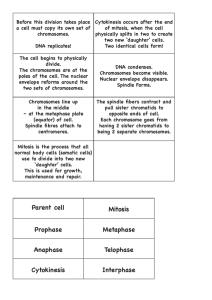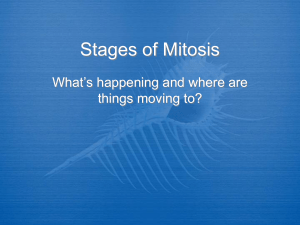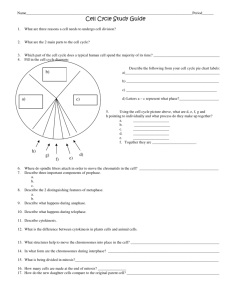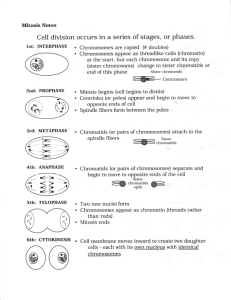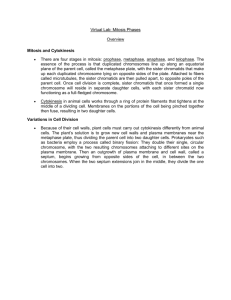Mitosis vs. Meiosis
advertisement
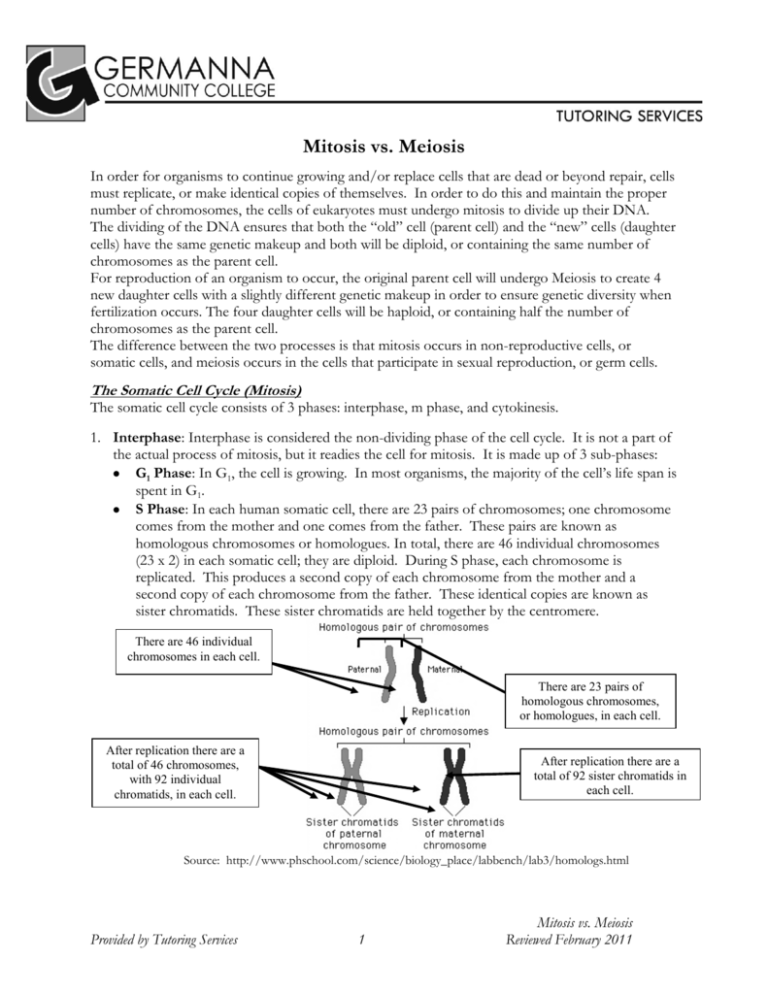
Mitosis vs. Meiosis In order for organisms to continue growing and/or replace cells that are dead or beyond repair, cells must replicate, or make identical copies of themselves. In order to do this and maintain the proper number of chromosomes, the cells of eukaryotes must undergo mitosis to divide up their DNA. The dividing of the DNA ensures that both the “old” cell (parent cell) and the “new” cells (daughter cells) have the same genetic makeup and both will be diploid, or containing the same number of chromosomes as the parent cell. For reproduction of an organism to occur, the original parent cell will undergo Meiosis to create 4 new daughter cells with a slightly different genetic makeup in order to ensure genetic diversity when fertilization occurs. The four daughter cells will be haploid, or containing half the number of chromosomes as the parent cell. The difference between the two processes is that mitosis occurs in non-reproductive cells, or somatic cells, and meiosis occurs in the cells that participate in sexual reproduction, or germ cells. The Somatic Cell Cycle (Mitosis) The somatic cell cycle consists of 3 phases: interphase, m phase, and cytokinesis. 1. Interphase: Interphase is considered the non-dividing phase of the cell cycle. It is not a part of the actual process of mitosis, but it readies the cell for mitosis. It is made up of 3 sub-phases: G1 Phase: In G1, the cell is growing. In most organisms, the majority of the cell’s life span is spent in G1. S Phase: In each human somatic cell, there are 23 pairs of chromosomes; one chromosome comes from the mother and one comes from the father. These pairs are known as homologous chromosomes or homologues. In total, there are 46 individual chromosomes (23 x 2) in each somatic cell; they are diploid. During S phase, each chromosome is replicated. This produces a second copy of each chromosome from the mother and a second copy of each chromosome from the father. These identical copies are known as sister chromatids. These sister chromatids are held together by the centromere. There are 46 individual chromosomes in each cell. There are 23 pairs of homologous chromosomes, or homologues, in each cell. After replication there are a total of 46 chromosomes, with 92 individual chromatids, in each cell. After replication there are a total of 92 sister chromatids in each cell. Source: http://www.phschool.com/science/biology_place/labbench/lab3/homologs.html Provided by Tutoring Services 1 Mitosis vs. Meiosis Reviewed February 2011 G2 Phase: During G2, the cell makes proteins that are used in cell division. One of the proteins will be used in the formation of microtubules. 2. M Phase: M phase is when mitosis actually begins to take place. By the end of M phase, the sister chromatids separate from the original chromosomes and form a new cell. The M phase is broken down into 4 sub-phases: Prophase, Metaphase, Anaphase, and Telephase. Prophase: During prophase, the nuclear envelope of the cell (which is where the 92 sister chromatids are contained) begins to break down. The centrioles, which are only present in animal cells, separate and each moves to an opposite end of the cell. As they move apart, a network of protein fibers that are made up of microtubules is left in their wake. These protein fibers are known as spindle fibers. As the centrioles take their places at opposite sides of the cell, they send out more spindle fibers. These spindle fibers seek out the sister chromatids that are present in the cell. Spindle fibers from one side of the cell attach to one of the sister chromatids. The spindle fibers from the other side of the cell attach to the other sister chromatids in the chromosome. They attach at a point called the kinetochore, which is a disk or protein that is on each side of the centromere. The spindle fibers will move the chromosomes until they are lined up at the spindle equator. Sister Chromatids Spindle Fibers Centrioles Kinetochore Source: http://www.sparknotes.com/testprep/books/sat2/biology/chapter7section1.rhtml Metaphase: During metaphase, each of the 46 chromosomes line up along the center of the cell at the metaphase plate. Sister Chromatids Metaphase Plate Source: http://www.sparknotes.com/testprep/books/sat2/biology/chapter6section4.rhtml Provided by Tutoring Services 2 Mitosis vs. Meiosis Anaphase: During anaphase, the centromere splits, allowing the sister chromatids to separate. The kinetochore spindle fibers shorten, allowing for 46 of the newlyfreed chromatids to be dragged to one end of the cell and the remaining 46 chromatids to be dragged to the opposite end of the cell. These separated sister chromatids are known from this point forward as daughter chromosomes. At the conclusion of anaphase, each end of the cell has an identical and complete set of 46 chromosomes or 23 pairs of homologous chromosomes; they are still diploid. Spindle fibers are being broken down and dragging newly-freed sister chromatids to opposite ends of the cell. Separated sister chromatids, now called chromosomes Source: http://www.sparknotes.com/testprep/books/sat2/biology/chapter6section4.rhtml Telophase: Telephase begins once the chromosomes have completed separating and reached the opposite poles of the cell. During telophase, what remains of the network of spindle fibers is dismantled. Also, around each complete set of chromosomes, a nuclear envelope begins to form and the daughter chromosomes begin to decondense. At this point, the actual process of mitosis is complete. Nuclear envelope begins to reform Chromosomes begin to decondense Source: http://www.sparknotes.com/testprep/books/sat2/biology/chapter6section4.rhtml Provided by Tutoring Services 3 Mitosis vs. Meiosis 3. Cytokinesis: Cytokinesis is the final stage of the cell cycle; it can occur anywhere from Anaphase into Telephase once the chromosomes have separated. The cytoplasm of the cell begins to split. It divides roughly in half. These two halves are identical copies of one another. They are now fully functioning cells; each is known as a daughter cell. The cell cycle for somatic cells is now complete and each daughter cell begins the process anew. Source: http://www.sparknotes.com/testprep/books/sat2/biology/chapter6section4.rhtml The Germ Cell Cycle (Meiosis) The germ cell cycle consists of three phases: interphase, meiosis I, and meiosis II. 1. Interphase: Interphase for germ cells is much the same as interphase for somatic cells. Germ cells are growing; chromosomes are replicating. It should be noted that germ cells also begin with 46 chromosomes, or 23 pairs of homologues, making them diploid. After replication of the chromosomes, there are 46 chromosomes (92 chromatids) present in the germ cells. 2. Meiosis I: Meiosis I is the first division, the reduction division, of meiosis. There are 4 sub-phases in meiosis I: Prophase I: During prophase I, homologous chromosomes line up side by side. They are physically in contact with one another. This process is known as synapsis. Synapsis is when crossing over occurs. During crossing over, DNA is exchanged between two nonsister chromatids of a homologous pair of chromosomes. The nonsister chromatids are both broken in the same places, removing an entire section from each. The section in one nonsister chromatid is swapped for the same section in the other nonsister chromatid. Crossing over produces “new” nonsister chromatids that are a mixture of maternal and paternal DNA and are tightly held together. Provided by Tutoring Services 4 Mitosis vs. Meiosis Homologous chromosomes line up side by side. Nonsister chromatids exchange segments of DNA from identical locations. Nonsister chromatids are now a mix of maternal and paternal DNA. Source: http://www.phschool.com/science/biology_place/labbench/lab3/crossovr.html Metaphase I: During metaphase I, the spindle apparatus forms from opposite ends of the cell. The spindle apparatus then sends out spindle fibers to attach to the chromosomes. However, since the homologous chromosomes are lined up side by side for crossing over, they are tightly held together. Therefore, the spindle fibers are only able to make contact with the kinetochore on the sister chromatid that is facing outward in each chromosome pair. Which chromosome is oriented toward which end of the cell is a matter of chance; each pair is independent of one another. Spindle Fibers Spindle fibers are only able to attach to the outermost kinetochores. Kinetochore Source: http://www.phschool.com/science/biology_place/labbench/lab3/crossovr.html Anaphase I: In anaphase I, the attachment of the spindle fibers is complete. The homologous chromosomes are pulled apart and move towards opposite ends of the cell. Do not confuse this with the pulling apart of sister chromatids! This is the point in which reduction occurs with 23 chromosomes moving to each pole. All possible combinations of genetic material are created from the independent assortment. At this point, the sister chromatids are still attached to each other. Homologous chromosomes are being pulled to opposite ends of the cell Source: http://www.sparknotes.com/testprep/books/sat2/biology/chapter7section1.rhtml Provided by Tutoring Services 5 Mitosis vs. Meiosis Telophase I: The chromosomes are now at opposite ends of the cell and begin to form two distinct chromosome clusters. At this point, nuclear division begins, and the parent cell is divided in half, forming 2 daughter cells. Each daughter cell will have half of the original 46 chromosomes, or 23 chromosomes. Each chromosome consists of 2 sister chromatids. The daughter cells now move in to the third and final phase of meiosis: meiosis II. At the end of meiosis I there are two haploid cells. Source: http://www.phschool.com/science/biology_place/labbench/lab3/concepts2.html 3. Meiosis II is the second division of meiosis. It occurs in both of the newly formed daughter cells simultaneously. Meiosis II is similar to Mitosis in that the sister chromatids are separated. It consists of 4 sub-phases: Prophase II, Metaphase II, Anaphase II, Telaphase II. Prophase II: During prophase II, the chromosomes begin to recondense and spindle fibers begin to form once again. These spindle fibers seek out the sister chromatids that are present in the cell. Spindle fibers from one side of the cell attach to one of the sister chromatids. The spindle fibers from the other side of the cell attach to the other sister chromatids of the chromosome. They attach at a point called the kinetochore, which is a disk or protein that is on each side of the centromere. The spindle fibers will move the chromosomes until they are lined up at the spindle equator. Source: http://www.phschool.com/science/biology_place/labbench/lab3/concepts2.html Metaphase II: During metaphase, each of the 23 chromosomes line up along the center of the cell at the metaphase plate. Source: http://www.phschool.com/science/biology_place/labbench/lab3/concepts2.html Provided by Tutoring Services 6 Mitosis vs. Meiosis Anaphase II: During anaphase II, the centromere splits, freeing the sister chromatids from each other. At this point, spindle fibers begin to shorten, pulling the newly-separated sister chromatids towards opposite ends of the cell. Unlike the sister chromatids in mitosis, the sister chromatids in meiosis are not genetically identical due to crossing over. Source: http://www.phschool.com/science/biology_place/labbench/lab3/concepts2.html Telophase II: During telophase II, cell division begins again in each of the two daughter cells, creating 4 daughter cells. Each of these 4 daughter cells contains 23 chromosomes, making them haploid, and none of the 4 is exactly alike (due to crossing over and independent assortment). None of the 4 haploid daughter cells are exactly alike. Source: http://www.sparknotes.com/testprep/books/sat2/biology/chapter7section1.rhtml Mitosis vs. Meiosis: A Quick Overview Mitosis 1. Occurs in somatic cells 2. No pairing of homogolous chromosomes 3. Does NOT have crossing over 4. 5. 6. 7. Meiosis Occurs in germ cells Homogolous chromosomes pair up Has crossing over, and independent assortment Cells split twice Produces 4 daughter cells Daughter cells are each genetically unique End as haploid (23 chromosomes) Cells split once Produces 2 daughter cells Daughter cells are identical End as diploid (46 chromosomes or 23 pairs) Provided by Tutoring Services 7 Mitosis vs. Meiosis


